RBSE Class 11 Biology Important Questions Chapter 7 Structural Organisation in Animals
Rajasthan Board RBSE Class 11 Biology Important Questions Chapter 7 Structural Organisation in Animals Important Questions and Answers.
RBSE Class 11 Biology Chapter 7 Important Questions Structural Organisation in Animals
Multiple Choice Questions
Question 1.
Select the correct route for the passage of sperms in male frogs:
(a) Testes → Bidder’s canal → Kidney → Vasa efferentia → Urinogential duct → Cloaca
(b) Testes → Vasa efferentia → Kidney → Seminal vesicle → urinogenital duct → Cloaca
(c) Testes → Vasa efferentia → Bidder’s canal → Ureter → Cloaca
(d) Testes Vasa efferentia → Kidney → Bidder’s canal → Urinogential duct → Cloaca
Answer:
(d) Testes Vasa efferentia → Kidney → Bidder’s canal → Urinogential duct → Cloaca

Question 2.
Frog’s heart when taken out of the body continues to beat for sometime.
Select the best option from the following statements.
I. Frog is a poikilotherm.
II. Frog does not have any coronary circulation.
III. Heart is myogenic in nature.
IV. Heart is autoexcitable.
(a) Only II
(b) Only IV
(c) I and II
(d) III and IV
Answer:
(d) III and IV
Question 3.
Which type of tissue correctly matches with its location?
Tissue - Location
(a) Areolar tissue - Tendons
(b) Transitional epithelium - Tip of nose
(c) Cuboidal epithelium - Linings of stomach
(d) Smooth muscle - Wall of intestine
Answer:
(d) Smooth muscle - Wall of intestine
Question 4.
Which of the following features is not present in periplaneta americana?
(a) Indeterminate and radial cleavage during embryonic development
(b) Exoskeleton composed of N - acetylglucosamine
(c) Metamerically segmented body
(d) Schizocoelom as body cavity
Answer:
(a) Indeterminate and radial cleavage during embryonic development
Question 5.
In male cockroaches, sperms are stored in which part of reproductive system?
(a) Seminal vesicles
(b) Mushroom glands
(c) Testes
(d) Vas deferens
Answer:
(a) Seminal vesicles
Question 6.
The body cells in cockroach discharge their nitrogenous waste in the Haemolymph mainly in the form of:
(a) ammonia
(b) potassium waste
(c) urea
(d) calcium carbonate
Answer:
(b) potassium waste
Question 7.
The function of the gap junction is to:
(a) Performing cementing to keep neighbouring cells together
(b) Facilitate communication between adjoining cells by connecting the cytoplasm for rapid transfer of ions, small molecules and some large molecules
(c) Separate two cells from each other
(d) Stop substance from leaking across a tissue
Answer:
(b) Facilitate communication between adjoining cells by connecting the cytoplasm for rapid transfer of ions, small molecules and some large molecules
Question 8.
Choose the correctly matched pair:
(a) Tendon: Specialised connective tissue
(b) Adipose tissue: Dense connective tissue
(c) Areolar tissue: Loose connective tissue
(d) Cartilage: Loose connective tissue
Answer:
(c) Areolar tissue: Loose connective tissue

Question 9.
Choose the correctly matched pair:
(a) Inner lining of salivary ducts: Ciliated epithelium
(b) Moist surface of buccal cavity: Glandular epithelium
(c) Tubular parts of nephrons: Cuboidal epithelium
(d) Inner surface of bronchioles: Squamous epithelium
Answer:
(c) Tubular parts of nephrons: Cuboidal epithelium
Question 10.
What external changes are visible after the last moult of a cockroach nymph?
(a) Mandibles become harder
(b) Anal cerci develop
(c) Both fare wings and hind wings develop
(d) Labium develops
Answer:
(c) Both fare wings and hind wings develop
Question 11.
Select the correct statement from the ones given below with respect to periplaneta americana:
(a) Nervous system located dorsally, consists of segmentally arranged ganglia joined by a pair of longitudinal connectives
(b) Males bear a pair of short thread - like anal styles
(c) There are 16 very long malpighian tubules present at the junctions of midgut and hindgut
(d) Grinding of food is carried out only by the mouth parts
Answer:
(b) Males bear a pair of short thread - like anal styles
Question 12.
The ciliated columnar epithelial cells in humans are known to occur in:
(a) Bronchioles and fallopian tubes
(b) Bile duct and oesophagus
(c) Fallopian tubes and urethra
(d) eustachian tube and stomach lining
Answer:
(a) Bronchioles and fallopian tubes
Question 13.
The kind of epithelium which forms the inner walls of blood vessels is:
(a) cuboidal epithelium
(b) columnar epithelium
(c) ciliated columnar epithelium
(d) squamous epithelium
Answer:
(d) squamous epithelium
Question 14.
The cell junctions called tight, adhering and gap junctions are found in:
(a) muscular tissue
(b) connective tissue
(c) epithelial tissue
(d) neural tissue
Answer:
(c) epithelial tissue
Question 15.
The kind of tissue that forms the supportive structure in our pinna (external ears) is also found in:
(a) vertebrae
(b) nails
(c) ear ossicles
(d) tip of the nose
Answer:
(d) tip of the nose
Question 16.
Which one of the following correctly describes the location of some body parts in the earthworm pheretima?
(a) Two pairs of accessory glands in 16 - 18 segments
(b) four pairs of spermathecae in 4 - 7 segments
(c) One pair of ovaries attached at intersegmental septum of 14th and 15th segments
(d) Two pairs of testes in 10th and 11th segments.
Answer:
(d) Two pairs of testes in 10th and 11th segments.
Question 17.
Compared to blood our lymph has:
(a) No plasma
(b) Plasma without proteins
(c) More WBCs and no RBCs
(d) More RBCs and less WBCs
Answer:
(c) More WBCs and no RBCs

Question 18.
The most active phagocytic white blood cells are:
(a) neutrophils and eosinophils
(b) lymphocytes and macrophages
(c) eosinophils and lymphocytes
(d) neutrophils and monocytes
Answer:
(d) neutrophils and monocytes
Question 19.
Which type of white blood cells are concerned with the release of histamine and the natural anticoagulant heparin?
(a) Neutrophils
(b) Basophils
(c) Eosinophils
(d) Monocytes
Answer:
(b) Basophils
Question 20.
Which one of the following mammalian cells in not capable of metabolising glucose to carbon - dioxide aerobically?
(a) White blood cells
(b) Unstriated muscle cells
(c) Liver cells
(d) Red blood cells
Answer:
(d) Red blood cells
Question 21.
In which one of the following preparations are you likely to come across cell junctions most frequently?
(a) Ciliated epithelium
(b) Thrombocytes
(c) Tendon
(d) Hyaline cartilage
Answer:
(a) Ciliated epithelium
Question 22.
A drop of each of the following, is placed separately on four slides. Which of them will not coagulate?
(a) Blood plasma
(b) Blood serum
(c) Sample from the thoracic duct of lymphatic system
(d) Whole blood from pulmonary vein
Answer:
(b) Blood serum
Question 23.
Areolar connective tissue joins:
(a) integument with muscles
(b) bones with muscles
(c) bones with bones
(d) fat body with muscles
Answer:
(a) integument with muscles
Question 24.
Mast cells of connective tissue contain?
(a) vasopressin and relaxin
(b) heparin and histamine
(c) heparin and calcitonin
(d) serotonin and melanin
Answer:
(b) heparin and histamine

Question 25.
Which one of the following contains the largest quantity of extracellular material?
(a) Myelinated nerve fibres
(b) Striated muscle
(c) Areolar tissue
(d) Stratified epithelium
Answer:
(c) Areolar tissue
Question 26.
Which cartilage is present at the end of long bones?
(a) Calcified cartilage
(b) Hyaline cartilage
(c) Elastic cartilage
(d) Fibrous cartilage
Answer:
(b) Hyaline cartilage
Question 27.
During an injury nasal septum gets damaged and for its recovery which cartilage is preferred?
(a) Hyaline cartilage
(b) Elastic cartilage
(c) Calcified cartilage
(d) Fibrous cartilage
Answer:
(a) Hyaline cartilage
Question 28.
Which cells do not form layer and remain structurally separate?
(a) Epithelial cells
(b) Muscle cells
(c) Nerve cells
(d) Gland cells
Answer:
(c) Nerve cells
Question 29.
If apices of bone such as femur of frog is kept in dilute HCl for about a week. It will:
(a) assume black colour
(b) shrink in size
(c) turn flexible
(d) crack into pieces
Answer:
(c) turn flexible
Question 30.
Simple epithelium is a tissue in which the cells are:
(a) hardened and provide support to the organ
(b) cemented directly to one another to form a single layer
(c) All of these
(d) None of these
Answer:
(c) All of these
Question 31.
The polysaccharide present in the matrix of cartilage is known as:
(a) cartilagin
(b) ossein
(c) chondrictin
(d) casein
Answer:
(c) chondrictin
Question 32.
Which of the following is not exclusively supplied with involuntary muscles?
(a) Muscular coats of blood vessels
(b) Muscles of ducts of glands
(c) Muscles of iris
(d) Muscle's of urethra
Answer:
(b) Muscles of ducts of glands

Question 33.
The functional unit of contractile system in striated muscle is:
(a) Myofibril
(b) Sarcomere
(c) Z - lines
(d) Cross bridges
Answer:
(b) Sarcomere
Question 34.
Stratum germinativum is an example of which kind of epithelium?
(a) Cuboidal
(b) Ciliated
(c) Columnar
(d) Squamous
Answer:
(c) Columnar
Question 35.
Basement membrane is made up of:
(a) Only epidermal cells
(b) Only endodermal cells
(c) Both (a) and (b)
(d) No cell at all, but is a product of epithelial cells
Answer:
(d) No cell at all, but is a product of epithelial cells
Question 36.
Epithelial tissue with thin flat cells appearing like packed tiles occur on:
(a) inner lining of cheek
(b) inner lining of stomach
(c) inner lining of fallopian tubes
(d) inner lining of ovary
Answer:
(d) inner lining of ovary
Question 37.
Vitamin - K is required for:
(a) formation of thromboplastin
(b) conversion of fibrinogen to fibrin
(c) conversion of prothrombin to thrombin
(d) synthesis of prothrombin
Answer:
(d) synthesis of prothrombin
Question 38.
Formation of cartilage bones involves:
(a) deposition of bony matter by osteoblasts and resorption by chondroblbsts
(b) deposition of bony matter by osteoclusts and resorption by chondroblasts
(c) only deposition of bony matter by osteoblasts only
(d) deposition of bony matter by osteoblasts only
Answer:
(d) deposition of bony matter by osteoblasts only
Question 39.
Component of blood responsible for producing antibodies is:
(a) thrombocytes
(b) monocytes
(c) erythrocytes
(d) lymphocytes
Answer:
(d) lymphocytes
Question 40.
Characteristics of smooth muscle fibres are:
(a) Spindle - shaped, unbranched, uninucleate and involuntary
(b) Spindle - shaped, unbranched, multinucleate and involuntary
(c) Cylindrical, unbranched, multinucleate and involuntary
(d) Cylindrical, unbranched, multinucleate and voluntary
Answer:
(a) Spindle - shaped, unbranched, uninucleate and involuntary
Question 41.
Histamine secreting cells are found in:
(a) connective tissue
(b) lungs
(c) muscular tissue
(d) nervous tissue
Answer:
(a) connective tissue
Question 42.
Haversian canal occurs in:
(a) humerus
(b) pubis
(c) scapula
(d) clavicle
Answer:
(a) humerus
Question 43.
Mineral found in red pigment of vertebrate blood is:
(a) magnesium
(b) iron
(c) calcium
(d) copper
Answser:
(b) iron
Very Short Answer Type Questions
Question 1.
What is a tissue?
Answer:
A group of cells that are similar in structure and work together to do a peculiar function is called tissue.
Question 2.
What is the utility of tissues in multicellular organisms?
Answer:
Tissues provide structural strength, mechanical strength, show division of labour.

Question 3.
Name the tissue responsible for movement in our body.
Answer:
1. Muscular tissue
2. Nervous tissue,combination of both the tissues are responsible for movement in our body.
Question 4.
Compound squamous epithelium present in which organ?
Answer:
Compound squamous epithelium present in Pharynx.
Question 5.
Which cells have poor power of regeneration?
Answer:
The Brain cells
Question 6.
Study of tissue is known as?
Answer:
Study of tissue is known as histology.
Question 7.
Name the tissue that forms the inner lining of our mouth.
Answer:
Squamous epithelium
Question 8.
Name the tissue that connect muscle to bone in humans.
Answer:
Tendons
Question 9.
Name the tissue that stores fat in our body.
Answer:
Adipose tissue
Question 10.
Name the Connective tissue with a fluid matrix.
Answer:
Blood
Question 11.
Name the tissue present in the brain.
Answer:
Nervous tissue
Question 12.
Name the tissue present in the skin.
Answer:
Striated squamous epithelium

Question 13.
Name the tissue present in the bone.
Answer:
Connective tissue
Question 14.
Name the tissue present in the lining of kidney tubule.
Answer:
Cuboidal epithelium tissue.
Question 15.
Write the examples of dense regular connective tissue.
Answer:
Tendon's and Ligaments
Question 16.
How many lateral hearts is present in Pheretima?
Answer:
4
Question 17.
In Pheretima, how many septa are absent?
Answer:
First four septa are absent.
Question 18.
In what way earthworms are useful?
Answer:
Earthworms makes the soil porous, leave their castings and take organic debris in the soil.
Quesiton 19.
Blood glands of Pheretima occurs in which segment?
Answer:
Blood glands of Pheretima occurs 4th, 5th and 6th segment.
Question 20.
The blood of Pheretima is of which colour?
Answer:
The blood of Pheretima is red in colour with haemoglobin in plasma.
Question 21.
Which feature is used to identify a male cockroach from a female cockroach.
Answer:
Presence of caudal styles.
Question 22.
In male cockroach, sperms are stored in which part of the reproductive system?
Answer:
Seminal vesicles.
Question 23.
The terga, sterna and pleura of cockroach body are joined by which structure?
Answer:
Arthrodial

Question 24.
Heart of cockroach is present in which segment?
Answer:
Heart of cockroach is located in 13th segment.
Question 25.
Name the excretory organ of cockroach.
Answer:
Malpighian tubules
Question 26.
What type of heart is found in cockroach?
Answer:
Chambered tubular heart.
Question 27.
How does respiration takes place in cockroach?
Answer:
As tha blood of cockroach, does not contain any respiratory pigment, so the oxygen reaches tissue directly through diffusion.
Question 28.
What type of mouth parts does a cockroach have?
Answer:
Cockroach have biting and chewing type of mouth parts.
Question 29.
The abdomen of cockroach have how many segments?
Answer:
The abdomen of cockroach have 10 segments.
Question 30.
How many malpighian tubules are present in cockroach?
Answer:
100 - 150 malpighian tubules are present in cockroach.
Question 31.
What are the functions of frog skin?
Answer:
The skin of frog performs respiration, protection and water absorption.
Question 32.
Name the gland that plays key role in the metamorphosis of frog's tadpole.
Answer:
Thyroid
Question 33.
Name the structure that remain unchanged during the metamorphosis of frog's tadpole.
Answer:
Nervous system

Question 34.
What is Oesophagus?
Answer:
Oesophagus is a short tube that opens into the stomach which in turn continues as the intestine, rectum and finally opens outside by cloaca.
Question 35.
What is cutaneous respiration?
Answer:
The respiration through skin inside water is called cutaneous respiration. Skin of frogs acts as aquatic respiratory organ.
Question 36.
What type of vascular system does a frog have?
Answer:
The frog have a well developed closed type of vascular system.
Question 37.
What does frog excretes?
Answer:
The frog excretes urea and thus is ureotelic animal.
Question 38.
A female frog lay how many ova at a time?
Answer:
A mature female can lay 2500 to 3000 ova at a time.
Question 39.
In what ways the frogs are beneficial to mankind?
Answer:
The frogs are beneficial for mankind because they eat insects and protects the crop.
Short Answer Type Questions - I
Question 1.
What is the specific function of the cardiac muscle?
Answer:
- Cardiac muscle cells are cylindrical, branched and uninucleated.
- They are involuntary muscles.
- They show rhythmically contraction and relaxation throughout life.
- Their rhythmic contraction and relaxation helps in pumping action of heart.

Question 2.
What does a neuron look like?
Answer:
A neuron consists of a cell body with a nucleus and cytoplasm, from which long thin hair like parts arise. Each neuron has a single long part called the axon, and many small, short branched parts called dendrite. An individual nerve cell is called neuron, it may be upto a metre long.
Question 3.
Give three features of cardiac muscles.
Answer:
Feature of cardiac muscles are:
- Heart muscles (cardiac muscles) are cylindrical, branched and uninucleated.
- They are striated muscle fibres.
- They are involuntary muscles, cannot be controlled by us.
Question 4.
What are the functions of areolar tissue?
Answer:
Areolar tissue are connective tissues found in animal. It is found between skin and muscles, around blood vessels and nerves and in the bone marrow. It fills the space inside the organs, supports internal organs and helps in the repair of tissues.
Question 5.
Write down the functions of Squamous, Cuboidal and Columnar Epithelium separately?
Answer:
Functions of Squamous, Cuboidal and Columnar Epithelium are:
|
Squamous Epithelium |
Cuboidal Epithelium |
Columnar Epithelium |
|
1. Protects the underlying parts of the body from mechanical injury. |
1. Provide mechanical support to the organs. |
1. Helps in absorption of nutrients. |
|
2. Prevent |
2. Secretion of gastric juices. |
2. Secretion of gastric juices. |
|
3. Prevent desiccation of organs. |
3. Absorption and excretion. |
3. Provide mechanical support to the organs. |
|
4. Facilitates diffusion of gases. |
|
|
Question 6.
Write the difference between the three types of muscle fibres.
Answer:
Differences between Striated, Smooth and Cardiac muscles:
|
Striated muscles |
Smooth muscles |
Cardiac muscles |
|
1. They are connected to bones (Skeletal muscles). |
1. They are found in alimentary canal and lungs. |
1. They are found in heart. |
|
2. They are voluntary muscles. |
2. They are involuntary muscles. |
2. They are involuntary in action. |
|
3. The cells are long, cylindrical with many nucleus and are unbranched. |
3. They are spindle in shape and have single nucleus. |
3. They are branched and have one nucleus. |
Question 7.
Describe cartilage and their type.
Answer:
Cartilage: A cartilage is flexible but tough connective tissue having ground substance or matrix, cells called chondrocytes and fibres. Cartilage cells generally occurs in clusters of 2 or 3 cells in small spaces or lacunae which are scattered in the matrix. The matrix is made up of a protein called chondrin. The cartilage is covered by a tough sheet of tissue called perichondrium. Most of the cartilages in vertebrate embryos are the space replaced by bones in adults.
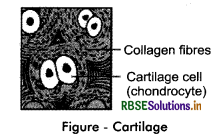
Depending upon matrix, cartilage are of three types:
Hyaline cartilage: The matrix is glass like semi transparent, homogenous and has fine collagen fibres. It is slightly elastic and compressible. It is found in - nose, larynx, trachea, ends of bone. It forms skeleton of cartilage fish.
Elastic cartilage: The matrix is semi opaque and has network of yellow elastic fibres. It is highly elastic and flexible. The tissue recover the shape quickly. It is found in - external ear, epiglottis, and pharynx (Eustachian tube).
Fibrous cartilage: The matrix has bundles of densely packed white collagen fibres. It provides great strength and little degree of flexibility. It acts as a shock absorber by giving a cushioning effect.
Short Answer Type Questions - II
Question 1.
Describe the external morphology of earthworm. Draw a well labelled diagram.
Answer:
Earthworms have long cylindrical body. The body is divided into more than hundred short segments which are similar (metameres about 100 - 120 in number). The dorsal surface of the body is marked by a dark median mid dorsal line (dorsal blood vessel) along the longitudinal axis of the body. The ventral surface is distinguished by the presence of genital openings (pores). Anterior end consists of the mouth and the prostomium, a lobe which serves as a covering for the mouth and as a wedge to force open cracks in the soil into which the earthworm may crawl. The prostomium is sensory in function. The first body segment is called the peristomium (buccal segment) which contains the mouth. In a mature worm, segments 14 - 16 are covered by a prominent dark band of glandular tissue called clitellum.
Thus the body is divisible into three prominent regions - preclitellar, clitellar and postclitellar segments. Four pairs of spermathecal apertures are situated on the ventro - lateral sides of the intersegmental grooves, i.e. 5th - 9th segments. A single female genital pore is present in the mid - ventral line of 14th segment. A pair of male genital pores is present on the ventro - lateral sides of the 18th segment. Numerous minute pores called nephridiopores open on the surface of the body. In each body segment, except the first, last and clitellum, there are rows of S - shaped setae, embedded in the epidermal pits in the middle of each segment. Setae can be extended or retracted. Their principal role is in locomotion.
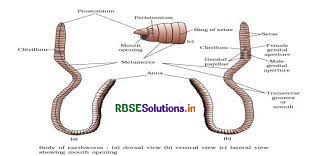
Question 2.
Briefly describe the circulatory system in earthworm.
Answer:
Pheretima exhibits a closed type of blood vascular system, consisting of blood vessels, capillaries and heart. (Figure 7.11). Due to closed circulatory system, blood is confined to the heart and blood vessels. Contractions keep blood circulating in one direction. Smaller blood vessels supply the gut, nerve cord, and the body wall. Blood glands are present on the 4th, 5th and 6th segments. They produce blood cells and haemoglobin which is dissolved in blood plasma. Blood cells are phagocytic in nature. Earthworms lack specialised breathing devices. Respiratory exchange occurs through moist body surface into their blood stream.
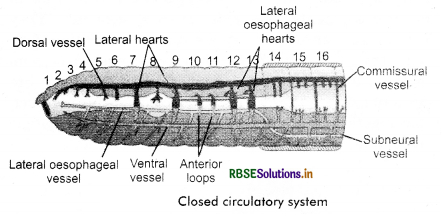

Question 3.
Briefly describe the external morphology of cockroach.
Answer:
The adults of the common species of cockroach, Periplaneta americana are about 34 - 53 mm long with wings that extend beyond the tip of the abdomen in males. The body of the cockroach is segmented and divisible into three distinct regions - head, thorax and abdomen (Figure 7.14). The entire body is covered by a hard chitinous exoskeleton (brown in colour). In each segment, exoskeleton has hardened plates called sclerites (tergites dorsally and sternites ventrally) that are joined to each other by a thin and flexible articular membrane (arthrodial membrane).
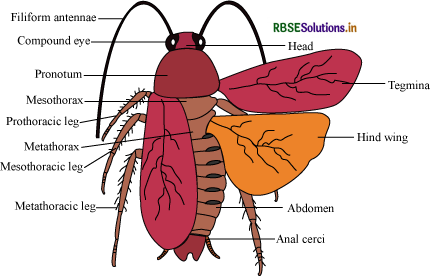
Question 4.
Describe the reproductive system of male in frog.
Answer:
Male reproductive organs consist of a pair of yellowish ovoid testes (Figure 7.21), which are found adhered to the upper part of kidneys by a double fold of peritoneum called mesorchium. Vasa efferentia are 10 - 12 in number that arise from testes. They enter the kidneys on their side and open into Bidder's canal. Finally it communicates with the urinogenital duct that comes out of the kidneys and opens into the cloaca. The cloaca is a small, median chamber that is used to pass faecal matter, urine and sperms to the exterior.

Question 5.
Describe the reproductive system of female frog.
Answer:
The female reproductive organs include a pair of ovaries. The ovaries are situated near kidneys and there is no functional connection with kidneys. A pair of oviduct arising from the ovaries opens into the cloaca separately. A mature female can lay 2500 to 3000 ova at a time. Fertilisation is external and takes place in water. Development involves a larval stage called tadpole. Tadpole undergoes metamorphosis to form the adult.
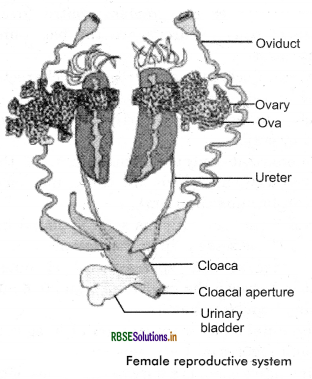
Long Answer Type Questions
Quesiton 1.
Classify and describe epithelial tissue on the basis of structural modification of cells.
Answer:
In general, epithelial tissues are classified by the number of their layers and by the shape and function of the cells. The three principal shapes associated with epithelial cells are squamous, cuboidal, and columnar. Squamous epithelium has cells that are wider than their height (flat and scale - like). This is found as the lining of the mouth, oesophagus, and including blood vessels, and in the alveoli of the lungs, the Bowman's capsule and the Loop of Henle. Cuboidal epithelium has cells whose height and width are approximately the same (cube shaped). Columnar epithelium has cells taller than they are wide (column - shaped). Columnar epithelium can be further classified into ciliated columnar epithelium and glandular columnar epithelium. On the basis of structural modification of the cells, simple epithelium is further divided into three types - squamous, cuboidal and columnar epithelium.

Question 2.
Classify and describe connective tissue on the basis of structure and function.
Answer:
Connective tissues are most abundant and widely distributed in the body of complex animals. They are named connective tissues because of their special function of linking and supporting other tissues/organs of the body. They range from soft connective tissues to specialised types, which Include cartilage, bone, adipose, and blood. In all connective tissues except blood, the cells secrete fibres of structural, proteins called collagen or elastin. The fibres provide strength, elasticity and flexibility to the tissue. These cells also secrete modified polysaccharides, which accumulate between cells and fibres and act as matrix (ground substance). Connective tissues are classified into three types:
- Loose connective tissue
- Dense connective tissue and
- Specialised connective tissue.
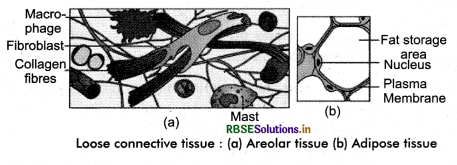
Question 3.
Draw a deat and well labelled diagram of the following:
(i) Alimentary canal of earthworm
(ii) Reproductive system of male and female cockroach
(iii) Reproductive system of male and female frog
Answer:
(i)
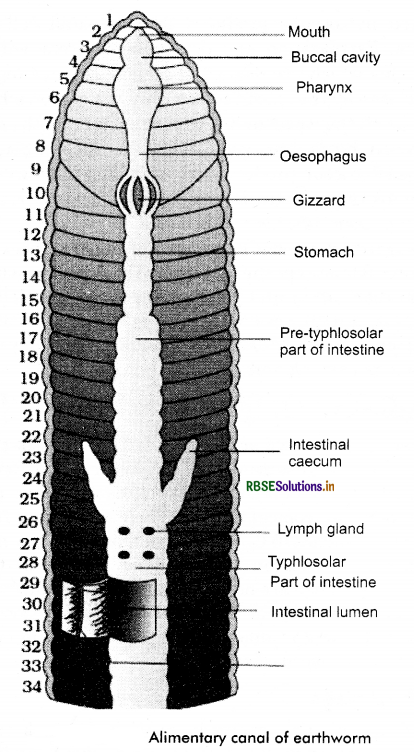
(ii)
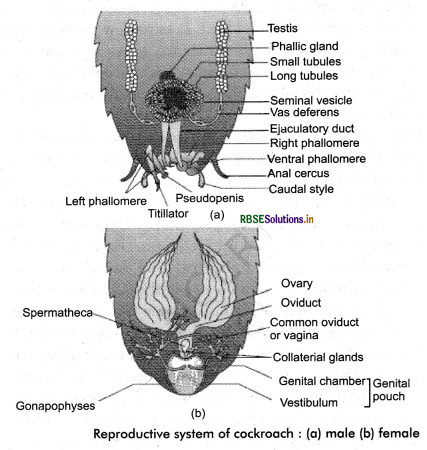
(iii)
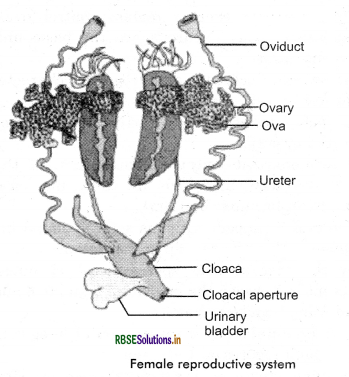
Question 4.
Describe the reproductive system in earthworm. Explain the gametic exchange in earthworm during mating.
Answer:
Earthworms are bisexual or monoecious or hermaphrodite. The male reproductive organ consists of testis sac, testes, seminal vesicles, spermiducal funnels, vasa deferentia, prostate glands and accessory glands. The female reproductive organ consists of ovaries, oviducts and spermathecae. During copulation, two earthworms get attached through their ventral surface with their anterior end pointing in opposite direction. This leads to exchange of sperms. During the process of coccon formation, the membrane receives ova coming from female genital aperture and sperms coming from spermathecal pores. The membrane is laid out on the ground and becomes closed. This structure is called cocoon (ootheca).
Gametic Exchange in Earthworm :
Earthworms are hermaphrodite animals; which means an individual has both the sexes.
A pair of male genital pore is present on the ventrolateral side of the 18th segment.
Four pairs of spermathecae are located in the 6th to 9th segment (one pair in each segment).
During copulation. spermatozoa get deposited in the spermatheca.
An earthworm needs to find another earthworm for mating. They juxtapose each other so that the male genital pores of one individual are opposite to the spermatheca of another individual.
Thus, a mutual exchange of spermatozoa takes place between the two individuals. Spermatozoa are exchanged in the form of packets: called spermatophores.
After that, mature egg cells and sperms are deposited in cocoons. Cocoons are made by the fluids secreted by gland cells of clitellum.
Cocoons are deposited in soil and fertilization and development of the embryo takes place inside the cocoons.
Question 5.
Describe the reproductive system in male and female cockroach with the help of diagram. Write down the difference between male and female cockroach.
Answer:
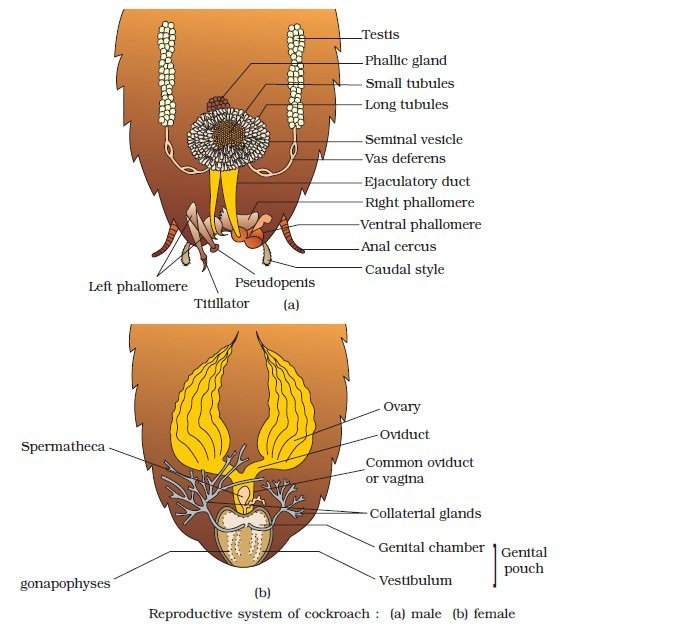
The cockroaches are dioecious (unisexual) animals. Male reproductive system consists of a pair of testes, vas deferens, ejaculatory duct, utricular gland and phallic gland. Female reproductive system consists of a pair of ovaries, oviduct, vagina, genital chamber and colleterial glands. Copulation occurs at night during the summer. The nymph, hatched from the ootheca, gradually grows into adult through the process of moulting.
Male Cockroach
- The body of male cockroach is smaller than the female cockroach's body.
- The abdomen of male cockroach is slender as well as the last segment of the abdomen is pointed.
- The wings of male cockroaches are larger.
- The antennae of male cockroach are smaller than that of the female’s cockroach antennae.
- In the 9th sternum of abdomen a pair of small, un-jointed anal styles along with the 10th tergum of abdomen a pair of long, palp - like jointed anal cerci are present.
- The sternum of mesothorax is not bifurcated in male cockroaches.
Female Cockroach
- The body of female cockroach is relatively larger than the male body.
- The abdomen of the female cockroach is boat - shaped and the last segment is blunt.
- The wings of female cockroaches are smaller.
- The antennae of female cockroaches are relatively larger than that of the males.
- There is only a pair of anal cerci is present in of female cockroach.
- The sternum of mesothorax is bifid in the female cockroach’s body.
Question 6.
Describe the complete digestive system in frog with the help of diagram.
Answer:
The body cavity of frog accommodates different organ systems such as digestive, circulatory, respiratory, nervous, excretory and reproductive systems with well developed structures and functions (Figure 7.20). The digestive system consists of alimentary canal and digestive glands. The alimentary canal is short because frogs are carnivores and hence the length of intestine is reduced. The mouth opens into the buccal cavity that leads to the oesophagus through pharynx. Oesophagus is a short tube that opens into the stomach which in turn continues as the intestine, rectum and finally opens outside by the cloaca.
Liver secretes bile that is stored in the gall bladder. Pancreas, a digestive gland produces pancreatic juice containing digestive enzymes. Food is captured by the bilobed tongue. Digestion of food takes place by the action of HC1 and gastric juices secreted from the walls of the stomach. Partially digested food called chyme is passed from stomach to the first part of the intestine, the duodenum. The duodenum receives bile from gall bladder and pancreatic juices from the pancreas through a common bile duct. Bile emulsifies fat and pancreatic juices digest carbohydrates and proteins.
Final digestion takes place in the intestine. Digested food is absorbed by the numerous finger-like folds in the inner wall of intestine called villi and microvilli. The undigested solid waste moves into the rectum and passes out through cloaca. Frogs respire on land and in the water by two different methods. In water, skin acts as aquatic respiratory organ (cutaneous respiration). Dissolved oxygen in the water is exchanged through the skin by diffusion.
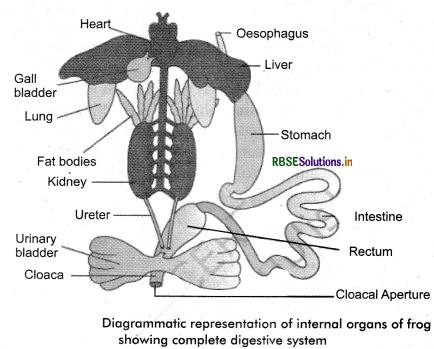
On land, the buccal cavity, skin and lungs act as the respiratory organs. The respiration by lungs is called pulmonary respiration. The lungs are a pair of elongated, pink coloured sac-like structures present in the upper part of the trunk region (thorax). Air enters through the nostrils into the buccal cavity and then to lungs. During aestivation and hibernation gaseous exchange takes place through skin.
The vascular system of frog is well-developed closed type. Frogs have a lymphatic system also. The blood vascular system involves heart, blood vessels and blood. The lymphatic system consists of lymph, lymph channels and lymph nodes. Heart is a muscular structure situated in the upper part of the body cavity. It has three chambers, two atria and one ventricle and is covered by a membrane called pericardium. A triangular structure Called sinus venosus joins the right atrium. It receives blood through the major veins called vena cava. The ventricle opens into a sac- like conous arteriosus on the ventral side of the heart. The blood from the heart is carried to all parts of the body by the arteries (arterial system). The veins collect blood from different parts of body to the heart and form the venous system.
Special venous connection between liver and intestine as well as the kidney and lower parts of the body are present in frogs. The former is called hepatic portal system and the later is called renal portal system. The blood is composed of plasma and cells. The blood cells are RBCs (red blood cells) or erythrocytes, WBCs (white blood cells) or leucocytes and platelets. RBC's are nucleated and contain red coloured pigment namely haemoglobin. The lymph is different from blood. It lacks few proteins and RBCs. The blood carries nutrients, gases and water to the respective sites during the circulation. The circulation of blood is achieved by the pumping action of the muscular heart.
The elimination of nitrogenous wastes is carried out by a well developed excretory system. The excretory system consists of a pair of kidneys, ureters, cloaca and urinary bladder. These are compact, dark red and bean like structures situated a little posteriorly in the body cavity on both sides of vertebral column. Each kidney is composed of several structural and functional units called uriniferous tubules or nephrons. Two ureters emerge from the kidneys in the male frogs. The ureters act as urinogenital duct which opens into the cloaca. In females the ureters and oviduct open separately in the cloaca. The thin-walled urinary bladder is present ventral to the rectum which also opens in the cloaca. The frog excretes.,urea and thus is a ureotelic animal. Excretory wastes are carried by blood into the kidney where it is separated and excreted.
The system for control and coordination is highly evolved in the frog. It includes both neural system and endocrine glands. The chemical coordination of various organs of the body is achieved by hormones which are secreted by the endocrine glands. The prominent endocrine glands found in frog are pituitary, thyroid, parathyroid, thymus, pineal body, pancreatic islets, adrenals and gonads. The nervous system is organized into a central nervous system (brain and spinal cord), a peripheral nervous system (cranial and spinal nerves) and an autonomic nervous system (sympathetic and parasympathetic). There are ten pairs of cranial nerves arising from the brain. Brain is enclosed in a bony structure called brain box (cranium). The brain is divided into fore-brain, mid-brain and hind-brain. Forebrain includes olfactory lobes, paired cerebral hemispheres and unpaired diencephalon. The midbrain is characterised by a pair of optic lobes. Hind-brain consists of cerebellum and medulla oblongata. The medulla oblongata passes out through the foramen magnum and continues into spinal cord, which is enclosed in the vertebral column.
